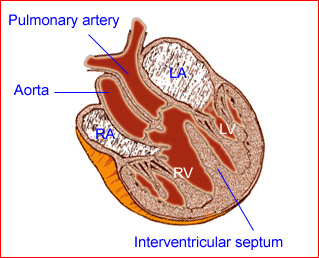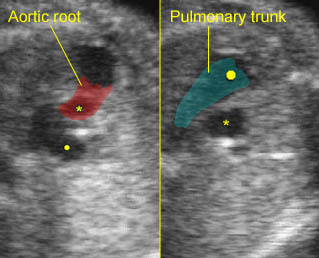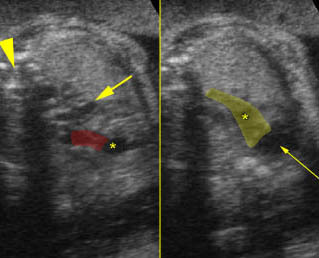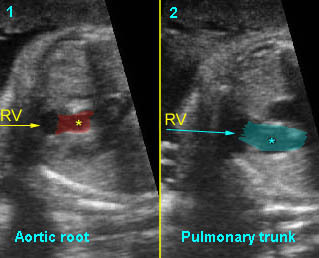Double-Outlet Right Ventricle (DORV)
DORV is a cardiac abnormality characterized by most of the aorta and pulmonary trunk being connected to the right ventricle.
Fig 1
Incidence: 0.03-0.07 in 1000 live births, accounting for 2% of structural cardiac defects.
Sonographic findings:
- Alignment of the two vessels totally or predominantly from the right ventricle.
- The presence in most cases of bilateral coni (subaortic and subpulmonary).
- The directions of the two vessels are not perpendicular to each other as usual; therefore, differentiation from truncus arteriosus or TOF may be difficult in some cases.
- Abnormal cardiac axis is common.
- Four-dimensional ultrasonography using color Doppler spatiotemporal image correlation is helpful in diagnosis.
- Thymic hypoplasia or aplasia may be noted in a case related to 22q11.2 deletion.
- Pitfalls: Although most cases can be identified antenatally as having a CHD, it is difficult to distinguish from other conotruncal abnormalities.
- Usually diagnosed after 16-18 weeks, but possible after 12-14 weeks with transvaginal ultrasound in some cases.

Fig 1: Schematic drawing of double outlets of right ventricle with VSD (LA = left atrium, LV = left ventricle, RA = right atrium, RV = right ventricle)
Video clips of Double-Outlet Right Ventricle (DORV)

Double outlet of right ventricle: Long-axis view: pulmonary (solid circle) and aortic root (*) arising from right ventricle

Double outlet of right ventricle:
Long-axis view:
– aortic root (*) arising from right ventricle pulmonary (arrow = aorta, arrowhead = spine)
– pulmonary artery (*) also arising from right ventricle

Double outlet of right ventricle:
Long-axis view
1) Aortic root arising from right ventricle
2) Pulmonary trunk arising from right ventricle
Associations: Ventricular septal defects, pulmonary stenosis, tetralogy of Fallot, transposition, univentricular hearts; extracardiac anomaly and chromosome abnormalities are also increased, especially chromosome 22q11 deletion, trisomy 13, and trisomy18.
Management: Careful prenatal and postnatal search for associated anomalies and karyotype (including FISH for chromosome 22q11 deletion) are indicated. Delivery should be performed where immediate pediatric cardiac consultation is available.
Prognosis: Poor when combined with other anomalies, but better for isolated DOVR with surgical correction, with the survival rate possibly being as high as more than 80%.

